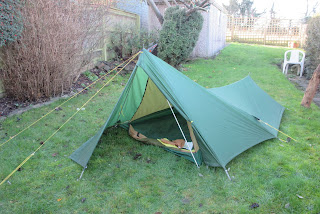I didn't get away from home till 11am. My route was the d'Arcy Dalton Way. I walked the section from its start at Wormleighton Reservoir on the Oxford Canal to home last year. It ends at Wayland's Smithy on The Ridgeway, 66.4 miles altogether. I joined the Way at Sarsden which seemed to be the quickest way to it.
 |
| Approaching Great Barrington |
 |
| I was quite well hidden. My tarp is the tiny grey splodge between trees.
|
I was away by 7am. A lovely morning and set to be quite warm. I went through Filkins, Broadwell, diverting from the Way to go through Langford in the hope of finding water. I took some from a stream in the village. At Radcot, I crossed over a quite small River Thames.
On then to the hamlet of Eaton Hastings. There were quite a few military planes going over from nearby Carterton. After Longcot and then Compton Beauchamp, I started the ascent to The Ridgeway.
 |
| The Ridgeway on the horizon |
At the top was some perfect woodland to tuck myself away in. The wildlife was very noisy but I slept well.
Next morning I had a leisurely few miles to meet up with the others at Lower Farncombe Farm just outside Lambourn. There was a good turn out of about twenty eight. A new Club member had come all the way from Düsseldorf just for the weekend. A group of us walked to Court Hill Centre just outside Letcombe Bassett where there are superb views to the north.
Sunday was the quickest way back to Lambourn to sort out some holiday related problems at home. This blog will be quiet for the next ten weeks or so but some reading can be had at http://scandijourney2016.blogspot.co.uk/































